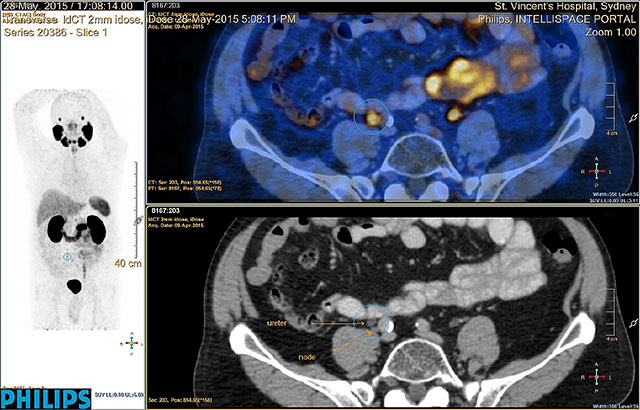Focal therapy for selective patients with prostate cancer is a relatively new treatment for a select group of patients for the treatment of localised prostate cancer.
The treatment is recommended for patients with localised prostate cancer stage T1 and T2 who are not candidates for prostatectomy because of their age, their general state of being or other associated disease, or patients who want alternatives to surgery, particularly to minimise the side effect profile. Additionally this treatment can be used for patients who have local recurrence after external beam radiotherapy (salvage treatment).
The treatment is performed transrectally, generally under a light anaesthetic. A probe is passed into the rectum. This probe emits a beam of high intensity convergent ultrasound. In the point where the ultrasounds are focused (focal point), the sudden and intense absorption of the ultrasound beam creates a sudden elevation of the temperature (from 85° to 100°) which destroys the cells located in the target zone.
The targeted zone destroyed by each shot is oval-shaped. Repeating the shots and moving the focal point between each shot enables one to destroy a volume of prostate that includes the tumour.

NanoKnife (IRE)
Focal therapy with the NanoKnife is suitable for men with small localised but significant prostate cancer. It uses high-powered electrical currents to create irreversible damage (irreversible electroporation) to the tumours and potentially protects adjacent structures. By being non-thermal it enables adjacent structures to be protected. It is a repeatable treatment.
It is only suitable in patients where there is a lesion visible on the MRI and the template transperineal biopsies have a perfect correlation with the MRI. The tumour has to be small and only on one side of the prostate and the patient has to refuse or be unsuitable for surgery or radiotherapy. After this treatment patients must accept that ongoing monitoring would be necessary.
The benefit of this procedure is to avoid significant side effects such as impotence and incontinence whilst still treating the index cancer
Articles and Studies
A concise explanantion, including types of HIFU available, by Prof John Emberton – PDF
Procedure guidance from the NHS National Institute of Health and Clinic Excellence – April 2012.
Lancet Oncology – Focal therapy for localised unifocal and multifocal prostate cancer
